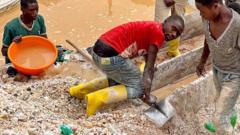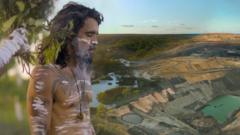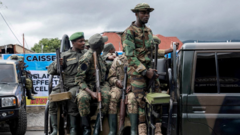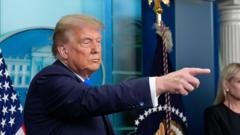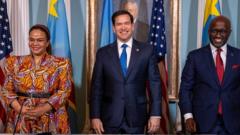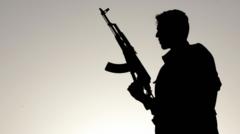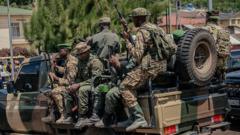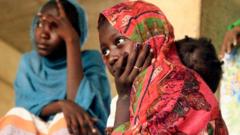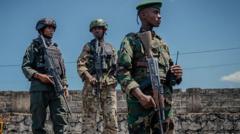Access to the Rubaya mine, controlled by M23 rebels, highlights the complex dynamics of coltan mining in eastern DR Congo, where over 10,000 workers extract minerals vital for technology amidst ongoing conflict and economic precarity.
Coltan Mining in Eastern Congo: A Fragile Balance of Hope and Exploitation
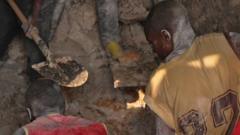
Coltan Mining in Eastern Congo: A Fragile Balance of Hope and Exploitation
The BBC explores the Rubaya mine, a crucial coltan source for mobile phones, revealing the interplay between local miners' struggles and the overarching armed conflict in the Democratic Republic of Congo.
In a rare glimpse into the Rubaya mine in eastern Democratic Republic of Congo (DRC), the BBC recently showcased a bustling scene under the watch of the M23 rebel group, which oversees operations in this critical source of coltan ore—an essential component for mobile phones and other electronic devices. With more than 10,000 workers toiling in challenging conditions, miners navigate a network of tunnels and pits in their quest for this high-demand mineral.
Patrice Musafiri, the mine supervisor appointed by the M23 since April 2022, asserted the workforce's industriousness, with miners drilling and filtering ore all day. Many, like Peter Osiasi, have made sacrifices for better lives thanks to mining. Osiasi, who has worked at the mine for five years, mentioned that his earnings have allowed him to save for family responsibilities, demonstrating both the precariousness and opportunities that come with such labor.
However, the mine's location in the lush Masisi Hills of North Kivu province—holding a substantial portion of the world's coltan reserves—also attracts significant international interest, from both investors and various armed factions that have historically fought for control over resources. The DRC's ongoing instability, stemming from local and ethnic tensions, complicates these interactions, especially with external actors like Rwanda, accused of supporting the M23.
Recent developments include a ceasefire agreement signed in Washington aimed at fostering peace but with no clear resolution to the complex social fabric of conflict within the region. The M23's control remains intact, leaving local findings about the risks and rewards of mining largely unresolved. While opportunities for investment from the United States could potentially uplift the community and improve working conditions, many workers express a desperate need for higher pay and better living standards.
Despite the promises of reform, basic infrastructure remains lacking. The prospect of American investment is viewed cautiously; while it could bring economic development, these efforts must be coupled with genuine increases in the miners' wages and community support. Local miners like Osiasi continue to openly call for peace and fairness amid the shadows of a tumultuous past and an uncertain future in one of the world’s richest but most war-torn regions. As diplomacy unfolds, the Rubaya mine remains a symbol of both hope and exploitation in the heart of Africa.
Patrice Musafiri, the mine supervisor appointed by the M23 since April 2022, asserted the workforce's industriousness, with miners drilling and filtering ore all day. Many, like Peter Osiasi, have made sacrifices for better lives thanks to mining. Osiasi, who has worked at the mine for five years, mentioned that his earnings have allowed him to save for family responsibilities, demonstrating both the precariousness and opportunities that come with such labor.
However, the mine's location in the lush Masisi Hills of North Kivu province—holding a substantial portion of the world's coltan reserves—also attracts significant international interest, from both investors and various armed factions that have historically fought for control over resources. The DRC's ongoing instability, stemming from local and ethnic tensions, complicates these interactions, especially with external actors like Rwanda, accused of supporting the M23.
Recent developments include a ceasefire agreement signed in Washington aimed at fostering peace but with no clear resolution to the complex social fabric of conflict within the region. The M23's control remains intact, leaving local findings about the risks and rewards of mining largely unresolved. While opportunities for investment from the United States could potentially uplift the community and improve working conditions, many workers express a desperate need for higher pay and better living standards.
Despite the promises of reform, basic infrastructure remains lacking. The prospect of American investment is viewed cautiously; while it could bring economic development, these efforts must be coupled with genuine increases in the miners' wages and community support. Local miners like Osiasi continue to openly call for peace and fairness amid the shadows of a tumultuous past and an uncertain future in one of the world’s richest but most war-torn regions. As diplomacy unfolds, the Rubaya mine remains a symbol of both hope and exploitation in the heart of Africa.


